Job interviews are not easy. If you want to apply for...

Botanical name: spruce european or common.
Homeland: Europe.
Lighting: moderate.
The soil: moist, nutritious.
Watering: moderate.
Max Height: 50 m
Average life expectancy: 250-300 years.
Landing: seeds and cuttings.
European spruce (ordinary) is the most common coniferous tree in Europe. Its range is so extensive that it does not affect only the North German Plain and the British Isles. Under favorable conditions, a tree can live up to 400 years.
The height of the tree is 50 m with a trunk width of 1 m. This is a slender tree, the crown is dense, pyramidal. Branches - horizontal or drooping, falling low along the trunk. The branches are collected in whorls. In the presence of sufficient lighting, the lower tier of branches remains for a very long time. The bark is smooth and brown when young.
By old age it becomes scaly-rough, gray or Brown color. Shoots of yellow or brown shades. May be naked or covered with red hairs. The kidneys are light brown. The needles are quite hard, green.
The shape of the needles is flattened-tetrahedral, the length is 1-3 cm. The needles stay on the tree for about 7 years. Mature cones of European spruce have an oblong-cylindrical shape. Their length is 10-15 cm, width - 3-4 cm. The cones ripen in October, but the seeds, as a rule, fall out in January-April. The length of the seeds is 3-5 mm. The seed has a yellowish wing, which is easily separated from it. The tree blooms at the age of 25-30 years.
Spruce wood has a yellowish white color with a slight pinkish tint. It is characterized as soft, light, shiny. The root system is horizontal, superficial, due to which the tree freely turns out of the ground even with strong winds.
Of all the species, Norway spruce (European) is the fastest growing. At a young age (up to 10 years), the increase is small, but increases rapidly with age. The annual growth is 50 cm. From 100-110 years old it begins to decline and by the age of 250 the plant begins to dry out. In some cases, it can live up to 500 years.
To date, several ornamental varieties of this species have been bred: weeping, compact, pin-shaped. All these varieties are often used in landscaping and landscaping. Norway spruce is often found in hedges from highways and railways.
Sandy, loamy, fertile, slightly moist soils are preferred. It tolerates short-term flooding, but does not tolerate long-term stagnation of water. Shade tolerant but needs adequate light to renew. Frost resistance is due to thin scales that protect the kidneys from frost. It tolerates a haircut perfectly, but suffers from polluted air, although it itself has phytoncidal, ionizing properties. Because of the superficial root system, the tree is afraid of windblows.
Very often seedlings can develop on a fallen trunk or a collapsing stump. This is explained by the fact that the plant tends to absorb nitrogen compounds. Mycorrhiza (a symbiosis of spruce roots and edible cap mushrooms) helps spruce trees extract nutrients from the soil. It is mycorrhiza that explains the presence of a large number of porcini mushrooms in spruce forests.
Reproduction occurs by seeds or layering. Moreover, the lower branches of the tree take root directly on the soil, which is rare for conifers. But multiply better cuttings and grafting, since during seed propagation there is a loss of characteristic decorative qualities.
New plants are unstable to dry air and soil. Therefore, on hot days, they require daily watering at the rate of 10-12 liters per 1 plant. Crown sprinkling is also desirable. After each watering, it is necessary to loosen the soil in the trunk circle, weed weeds and mulch with peat.
If spruce grows as a hedge, then it requires special shaping. With cropping, you can achieve the effect of an impenetrable green wall. In other cases, in autumn and spring, diseased, dry, broken branches are removed from the trees. And the main formation of a beautiful regular crown occurs naturally. However, with the simultaneous growth of 2 tops, one must be removed, cutting it out at the base.
Only young Christmas trees need special preparation for winter, except for frost, they require protection from direct sun rays causing burns. Under young plants, the soil must be mulched, and the needles are covered with spruce branches, non-woven material or craft paper.
This coniferous tree is an excellent "shield" on suburban area used as a fence. You can plant trees in the garden itself, but only if you are ready to regularly limit the growth of their root system, otherwise these trees will oppress other plants on the site.
To get started, check out the photo and description of the common spruce 0 tall (up to 20–50 m) tree with a trunk over 1 m in diameter. The cone-shaped crown with drooping or spaced branches remains sharp throughout the entire period of life. The bark is brown, rough, fissured. Shoots are brown, red or reddish-yellow, glabrous or sparsely hairy. Kidneys 4-5 mm long, ovoid-cone-shaped, light brown.
Pay attention to the photo - spruce needles are 10–25 mm long, 1–1.5 mm thick, tetrahedral, sharp, shiny, bright or dark green:
![]()
![]()
Needles can last about 6-7 years. Cones 10–15 cm long, 3–4 cm wide, at first light green or dark purple, mature light brown or reddish brown, shiny, with convex, serrated scales along the edge. They ripen in October, open in the second half of winter. The seeds of common spruce are 2–5 mm long, equipped with a light brown wing, and are sown in the second half of winter.
This tree can live from 250 to 500 years. When describing common spruce, it is always noted that for the first 10–15 years it grows very slowly - 50 cm per year, then the growth rate changes to rapid.
The origin of Norway spruce is Europe, in Russia it is distributed to the Urals, forms pure or mixed forests with birch, linden, maple, oak. In the mountains it rises up to 2000 m above sea level.
Norway spruce grows in the forest zone of the European part of the continent in mixed or pure forests, being a species of local flora.

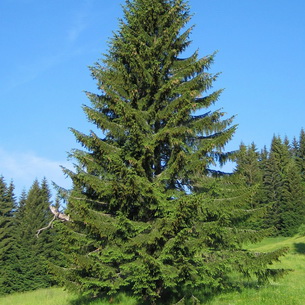
Common spruce grows on any soil, even marshy. Prefers sun, but can grow in partial shade and even shade. It is precisely because of its ability to grow in the shade that any mixed forest gradually becomes spruce, because under the canopy of deciduous plants, young Christmas trees easily grow from seeds spilled from mature cones of an adult tree, but young hardwoods usually die due to lack of light. . In coniferous forests, nothing ever grows under trees, and practically no one lives in these forests. There is silence in them.
The spruce has a superficial root system, and since the mighty crown, which easily reaches 20–60 m, has a large windage, a strong wind easily turns the spruce out of the soil. When planting a spruce, estimate in advance the prevailing wind direction so that during a hurricane it does not tip over on your house and break it.
Norway spruce is used in pulp and paper production, for the manufacture of musical instruments, containers, sleepers, lumber. The bark goes to get tanning agents.
Norway spruce has many garden forms: weeping 'Virgata', columnar 'Columnaris', spherical 'Pumila', dwarf 'Procumbens', as well as forms with different needle colors: gray 'Glauca', yellow 'Aurea', variegated white 'Argentea'.
All species and varieties of common spruce have a very heterogeneous appearance, which is explained by various types branching. These types are inherited, the most decorative of them are separated into separate varieties and are widely cultivated. According to the types of branching, the following varieties are distinguished: comb - branches are horizontal and hanging down; incorrectly combed; compact - the branches are horizontal and densely covered with shortly branched shoots; flat - the branches are widely branched and located in a horizontal plane; brush-like - the branches have short thick branches with small brush-shaped branches hanging from them. The most popular varieties are:
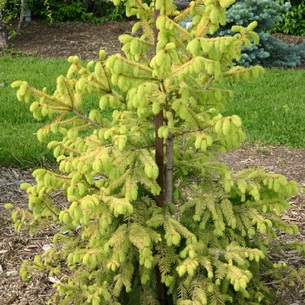



Acrocon (Acrocona), Aurea Magnifica (Golden Gorgeous - Aurea Magnifica), Berry (Barryi), Echiniformis (Spiny - Echiniformis).
Norway spruce also has a huge variety of dwarf varieties, most of which have a compact crown with stiff dark green needles.
As you can see in the photo, there are varieties of common spruce with a spherical and hemispherical crown no more than 1.5 m high, as well as with creeping shoots ("Inversa", "Repens"):
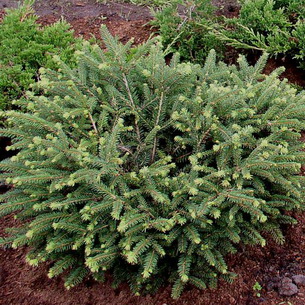
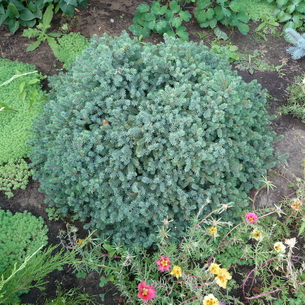
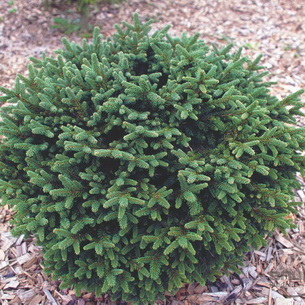

The most miniature varieties, no more than 50 cm in height: little gem», « Pumila», « Pygmaea».
Growing spruce is possible from the Far North to the subtropics. Spruce is propagated by seeds. Garden forms - cuttings and rarely grafting. Varietal characteristics are preserved only with the vegetative method of reproduction. When summer cuttings are treated with a 0.01% solution of indolylbutyric acid, trees take root by 14%.

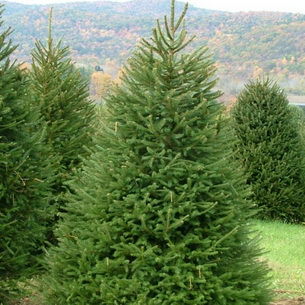
Spruces are shade-tolerant, but grow better with sufficient light. They suffer from air pollution, which primarily affects the life expectancy of needles. At a young age, they can be quite picky. They grow slowly, especially in the first years of life, do not like transplantation and cannot stand soil compaction as well as close groundwater. Trees are sensitive to early spring frosts.
For planting and successful care of common spruce, the soil must have the following composition: turf, leaf land, peat, sand, taken in a ratio of 2:2:1:1. Drainage: a layer of broken bricks and sand 15–20 cm.
Norway spruce prefers loamy and sandy soils. Shelter for the winter is necessary only for some decorative forms and only at a young age.
Of course, for a small garden, an ordinary spruce from the forest is not suitable, it is better to look in nurseries for a bushy form with a flat crown, reaching a height of no more than a meter in adulthood, or even start a creeping Christmas tree.
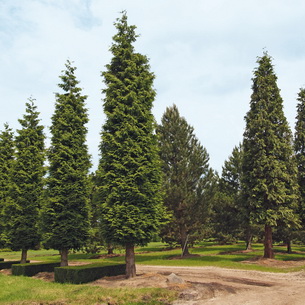
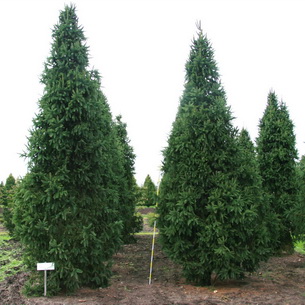
Common spruce grows well in Central Russia. These trees are adapted to the local climate, so they do not require special care. Spruces can grow on different types of soil, preferring loam. The main difficulty associated with their cultivation is maintaining the optimal level of soil moisture. Ordinary spruces do not like when the soil is swamped, so you need to loosen and cultivate the land, ensure proper drainage. This species is relatively shade tolerant, and the best location will be partial shade, adjacent to larger trees or buildings. Since ordinary spruces are ubiquitous in the surrounding forest areas, it will not be difficult to collect viable seeds or find a cutting suitable for propagation. Ordinary spruces are not propagated by grafting, with the exception of decorative forms.
In order for the spruces to be lush from top to bottom, it is necessary to unscrew the top from a certain moment. And the sooner you start doing this, the thicker it will be.


How to form an ordinary spruce in order to have beautiful trees on your site? In the spring, when a young and green shoot will go, while the needles on it are still soft, hold the base of the shoot with the fingers of your left hand, and right hand just twist it. There will be stumps 2–3 cm high. This will be the annual growth of the Christmas tree. For spruce, this operation is harmless. As soon as you destroy the top, the nearest dormant buds at the base of the broken sprout will immediately grow. One of these shoots will try to replace the top and start growing vertically, and you will twist it again. You will stop all attempts to grow a new spruce top every spring, leaving only a small stump from the annual growth. Thus, the tiers of horizontal branches will be located close to each other, and the Christmas tree will become very dense, and most importantly, this simple but annual trick will not allow the Christmas trees to swing into the sky. In addition, the experience of gardeners shows that densely planted spruces (if they are not shortened) begin to lose their lower branches. And over time, instead of a green fence, a colonnade grows from bare trunks in the lower part.
The video "Formation of common spruce" shows how to unscrew the top:
But you should not cut the ends of the branches, because, as a rule, this leads to the drying of the entire branch, besides, the trimmed ends are too noticeable. It's better to pinch them. It is done like this: take in your left hand a handful of green "tails" that appeared at the ends of the branches in the spring, and cut off their tips with your right hand. From the parts of the "tails" remaining at the ends of the branches, branches will go, which again will make the branches thicker.
If you cut off the top of an overgrown spruce, then the branch closest to the sawn top will try to take its place, rising to a vertical position. In this case, the trunk will turn out to be a curve.
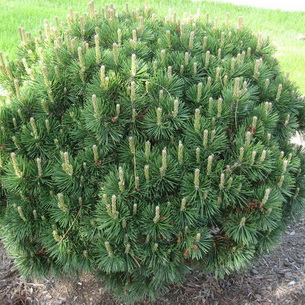

Dwarf spruces are unpretentious and extremely hardy. They prefer a well-lit place and moderately moist soils rich in nutrients. The exception is rather capricious varieties of gray spruce, which need shelter for the winter and shading from the scorching spring sun. For the formation of a beautiful spruce crown, an annual shearing of the dominant and lateral shoots is necessary at the time of their growth.
Watch the video "Pruning an ordinary spruce" to properly perform this procedure:
Norway spruce is used in groups, as a tapeworm, sheared hedge, alley. There are more than 120 garden varieties of common spruce known that can satisfy all the needs of amateur gardeners and landscape architects.
Here you can see a hedge from an ordinary spruce on a personal plot:
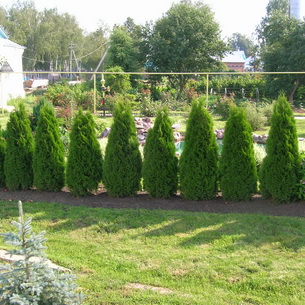
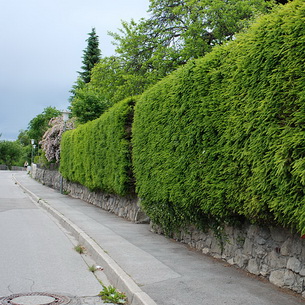
Norway spruce- a large tree. The plant is best planted with north side, outside the lot, behind a ditch at the very edge of the road that runs past the lot. In addition, such a "living fence" will perfectly close the garden from the north wind. If you are planting spruces as a green fence, then they should be planted at a distance of 80–100 cm.
You can, of course, plant a spruce on the site itself, but then you must definitely limit its root system. It is necessary to outline some kind of platform, and every year to cut off the roots with a shovel, trying to go beyond the allotted boundaries. Since spruce has a shallow root system, you won’t have to dig deep, but it’s still a tedious job, and you can skip a couple of times, and it will quickly stretch its tentacle roots to all your plants. It’s easier to do this: if you have an old concrete ring that for some reason was not used to create a well, you can bury it 90 cm - 1 m. If there is no ring, then you can dig a hole, make a formwork and pour a concrete square bottomless box. You can also bury the slate, but the roots of spruce will gradually destroy it. If you try to bury the iron, it will rot in 8-10 years, and the spruce will spread further. The space should be approximately 90 x 90 cm square or meter by meter. The soil you dug up can be put back in, you don't need particularly fertile soil, you just want spruce to grow slowly in poor soil. It will grow, don't worry. She is very hardy and also shade tolerant. Therefore, if you have 4 apple trees, then in the center between them you can plant a spruce, limiting its root system. It will be its smell, quite sharp, successfully protect your fruit trees from flying pests of apple trees, as the spruce smell will disorient them. It seems that they fly to the smell of their nurse - apple trees, and here some other suspicious smell is added. Fearing to leave their offspring on such an apple tree, pests, as a rule, fly by.
Spruce is a coniferous evergreen tree of the pine family. This is a riddle about her: "Winter and summer in one color." The message will take a closer look at this interesting tree, talk about where it grows and how it is used in the national economy.
A Christmas tree is a slender tree that can grow up to 35 meters high. The first 10 years it grows very slowly - a few cm per year, then the growth rate increases, but after 100-120 years it slows down again. It has a pyramidal (triangular) crown with a sharp top. The branches are located densely along the entire trunk. It is often difficult to see behind spruce paws.
In a young tree, the bark is smooth gray-brown in color; in an old tree, the bark becomes gray and peels off in thin plates. The needles are dark green and shiny, sharp and prickly. The needles are much shorter than those of pine, up to 3 cm long.
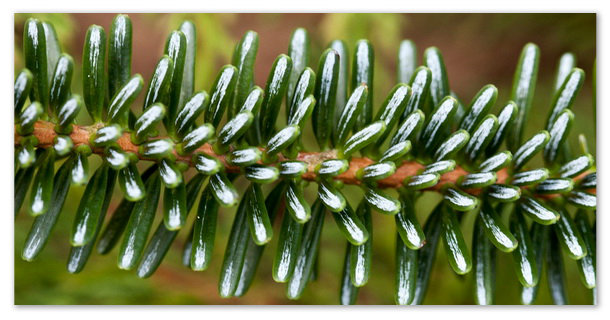
They firmly hold on the branches for 7-10 years. But in urban conditions, with strong smoke in the air, the life expectancy of the needles is greatly reduced: it falls off after 3 years.
The root system of spruce is located close to the surface, so a strong wind can knock down a tree.
Spruce is a long-liver, she lives 250-300 years.
She grows throughout the Northern Hemisphere. It can be found in Central and Northern Europe. It is ubiquitous in Russia: in Siberia, the Urals, Far East, in the Caucasus, in the steppe zone. It also grows in China and Japan.
In total there are 50 kinds oil. The most common: Siberian, European, Caucasian, Canadian, white, red, black.
The Christmas tree is the basis of the taiga. It grows in mixed forests, adjoining well with pine, oak, linden, aspen, hazel. It also forms pure spruce forests, which have a number of features:
In order for spruce to grow well, it needs the following conditions:
Spruce is a monoecious plant. This means that male spikelets and female cones grow on the same tree. Propagated by seeds whose germination is very good. Cones open in late November - early December, the seeds fall out, they are picked up by the wind and spread far around the neighborhood.
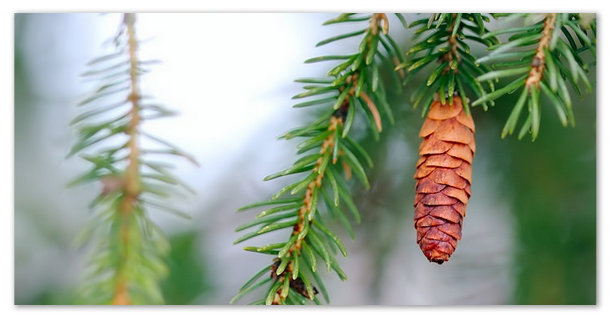
In early spring, the seed awakens and begins to grow. The main condition for the sprouts to take root and develop well is a warm spring, because they die during spring frosts.
Spruce plantations can often be seen in sanatoriums. Because their needles emit phytoncides that purify and disinfect the air. Also, spruce often becomes the basis of landscapes in personal plots.
Quality musical instruments are made from this tree. Soft wood is used to make paper, rayon, and smokeless powder. Get resin, tar, rosin, turpentine.
Spruce cones are widely used in traditional medicine. Healers believe that the tree is a donor tree, if you lean against it and stand like that for several minutes, it will give a person energy and strength.
forest guest waiting for New Year kids.
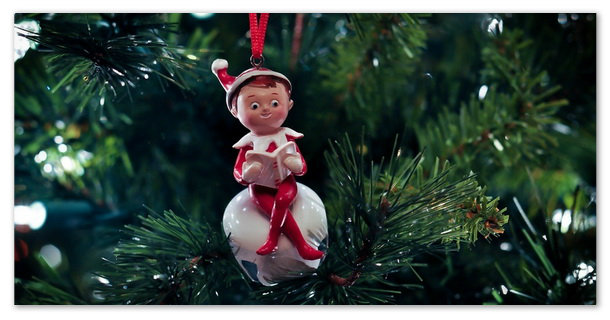
How much joy she brings, filling the house with a special forest smell and pleasing the eye with her beauty!
If this message was useful to you, I would be glad to see you
Spruce (Picea)- genus of evergreen conifers. One of its main representatives- Norway spruce(R. abies ) -known to us since childhood. Spruces are widespread in the Northern Hemisphere, and have long been widely used in landscape design. They are loved for their recognizable cone-shaped Christmas tree. In an extensive list of coniferous species used in green building, spruce occupies one of the leading places.
The ancient Roman name of the plant presumably comes from "pix" - resin. The genus includes about 50 species distributed in Northern Europe, Northeast and Central Asia, North America, Central and Western China. Representatives of the genus are monoecious, tall (more than 50 m), slender, evergreen, long-lived trees with a dense, narrow or wide conical crown, consisting of indistinctly whorled branches, with stiff, prickly needles, rhombic in cross section, lasts 6-9 years . The needles are attached to the shoots on special outgrowths of the bark - leaf pads, clearly visible after its fall. By this morphological feature, spruce shoots differ well from fir shoots. Cones are oblong, at the ends of last year's shoots, mainly of the upper branches. They ripen in the first year. Winged seed. Almost every species has a number of decorative forms.
Norway spruce, or European- Picea abies (L.) Karst. Homeland - Europe. Mountains of Western Europe, forest zone of the European part of Russia (up to the Urals). Forms pure or mixed forests. Protected in nature reserves.
|
|
Tree 30-35 (50) m high, crown diameter 6-8 m, trunk diameter up to 1.2 (2.4) m. The crown is dense, wide-conical, with a sharp apex. The bark at a young age is brownish, smooth, then reddish-brown, scaly-rough. The needles are needle-shaped, tetrahedral, pointed, 1-2 cm long, 0.1 cm thick, dark green, stored on branches for 6-12 years. Blooms in May. Male spikelets are reddish-yellow, female cones are purple or green. Cones are cylindrical, 10-15 cm long, 3-4 cm wide, immature cones are light green or dark purple, mature ones are light brown or reddish brown, hanging down. Annual growth in height - 50 cm, in width - 15 cm. Up to 10-15 years it grows slowly, then quickly. Life expectancy is 250-300 years. Winter hardiness is high. |
Norway spruce is heterogeneous in appearance, which is due to the different types of its branching. These types are inherited, and the most decorative of them are singled out, given specific names and widely introduced into culture.
The types of branching are: comb-shaped- branches of the first order are horizontal, the second - thin, comb-shaped, hanging down; incorrectly combed- branches of the second order are located incorrectly comb; compact- branches of the first order are relatively horizontal, of medium length, densely covered with shortly branched branches of the second order; flat- branches of the first order horizontally widely branched; brush-like- branches of the first order have short thick branches, with small branches hanging like a brush from them.
In addition to these, the most commonly used decorative forms:
| THE FORM | DESCRIPTION |
| "Akrokona" ("Asrosopa") |
The variety was bred to Finland in 1890. The height of the tree is 2-3 m, the diameter of the crown is 2-4 m, the crown is wide-conical. The bark at a young age is brownish, smooth, later - reddish-brown, scaly-rough. The needles are needle-shaped, four-sided, pointed, 1-2 cm long, 0.1 cm thick, dark green. Remains on branches for 6-12 years. Blooms in May. Male spikelets are reddish-yellow, female cones are bright purple. Cones are cylindrical, large. Immature cones are bright, red, mature - light brown or reddish-brown, hanging down. Annual growth in height - 10 cm, width 8 cm. It grows slowly. Shade-tolerant, at a young age may suffer from spring sunburn. The soil prefers fresh, well-drained, acidic, sandy and loamy, does not tolerate stagnant water, salinity and dryness of the soil. It is frost-resistant, but at young age can suffer from spring frosts. The cones look exceptionally beautiful. Application: in single landings, groups, alleys. |
| "Aurea" ( "Aurea") |
The height of the tree is usually up to 10 m. The branches are horizontally arranged. The needles are shiny, yellowish-white, easily burnt in the sun, while in the shade the needles remain pale. Frost-resistant. In culture, it is found in Ukraine, Belarus, Lithuania, recently brought to Russia. Recommended for group plantings. |
| "Aurea Magnifica", Golden Magnificent ("Aurea Magnifica") |
Undersized form, bushy, up to 3 m in height. Shoots are horizontal and raised above the ground. The needles are light yellow-golden, orange-yellow in winter. One of the most beautiful yellow-colored forms of Norway spruce. Great golden shape. Propagated by grafting, cuttings. Recommended for single and group plantings in gardens, as well as in rock gardens. |
| "Berry" ("Barry i" ) |
Strong, powerful dwarf form. Young plants have a rounded crown. By old age, the branches grow unevenly in different directions, become quite long, raised. Young shoots are orange-brown, at the ends with large buds surrounded by needles. The needles are shiny, dark green, about 10 mm long, blunt, directed forward and upward. |
| "Clanbrassiliana" ("Clanbrassilia") |
Dwarf form, in appearance resembles a hornet's nest. Old plants have a height of about 1.5 m, rarely 2 m. The shoots are thin, curved. The annual growth is 2-5 cm. From above, the shoots are light, gray-brown, from below - white, like cream, to greenish-white, shiny, bare. There are varieties with long needles on powerful shoots and with short needles on weak shoots. The needles are almost radially spaced, about 5-10 mm long, shiny, light green, densely cover the shoots, in the middle the needles are the widest, dense, flat in section, keeled, in the upper half with a long and sharp, fragile tip. Old branches are recommended to be removed so that the plants look more impressive. The form is currently widely cultivated in Europe. |
| "Columnaris" ("Columnaris") |
Tree with a columnar crown. Height up to 15 m, crown diameter up to 1.5 m. The bark at a young age is brownish, smooth, then reddish-brown, scaly-rough. The needles are needle-shaped, tetrahedral, pointed, 1-2 cm long, 0.1 cm thick, dark green. Remains on branches for 6-12 years. Grows slowly. Shade-tolerant. May suffer from spring sunburn at a young age. Prefers fresh, well-drained, acidic sandy and loamy soils, does not tolerate stagnant water, salinity and dryness of the soil. It is frost-resistant, but at young age can suffer from spring frosts. Application: single landings, groups, alleys. |
| "Compact" ("Compacta") |
Dwarf form, usually about 1.5-2m tall. Old plants sometimes reach 6 m in height with the same crown width. Shoots are numerous, short, raised in the upper part of the crown, brown. The needles are about 9 mm long, shorter towards the top of the shoot, shiny, green. |
| "Conica" |
Dwarf form, squat, with an obovate crown. It grows quite quickly, the annual growth is 3-6 cm. The branches are raised, tightly pressed against each other, thin, light or dark brown. The needles are radial and densely arranged, thin, soft, light green, 3-6 mm long. |
| "Cranstony" ("Cranstonii") |
Tree 10-15 m tall, with a loose, wide-conical crown and powerful branches. The needles are protruding, dark green, strongly compressed, up to 30 mm long, often slightly wavy. The shoots are loosely arranged, branches weakly, sometimes side shoots are absent. Grows slowly. The form is close to "Virgate" (serpentine), but more bushy. With seed propagation, 12% inherit the form. Recommended for solitary plantings in gardens or on the stalls in parks. |
| "Echiniformis", prickly ("Echiniformis") |
Dwarf, slow-growing form, reaching 20 cm in height and 40 cm in width. The crown is cushion-shaped, unevenly developed in different directions. Shoots are light brown, glabrous, slightly shiny, hard, relatively thick. Annual growth is 15-20 mm. The kidneys are light brown, large, cylindrical, rounded. The needles are from yellow-green to gray-green, the lower needles are flat with a short sharp tip, the upper stellate, located under the final cone. Propagated by seeds and grafting. Recommended for group and single plantings in rocky gardens, for growing in containers, for landscaping balconies and roofs, for cemeteries. |
| "Krasnoplodnaya" ("Erythrocarpa" (Purk.) Rehder) |
It grows slowly, the annual growth is about 3 cm. It does not produce dust. Winter hardiness is high. It is not found in the landscaping of Moscow. |
| "Gregoriana" ("Gregoryana") |
Dwarf form, 60-80 cm tall. It grows extremely slowly. The annual growth of shoots is about 20 mm. The crown is rounded, cushion-shaped. Shoots are thick, curved, strongly branched, light brown, slightly pubescent. The buds are yellow-green, rounded, collected 10 at the end of the shoot. The needles are gray-green, with a sharp end, 8-12 mm long. The lower needles are located radially, the upper ones are star-shaped, opening the kidney. A well-known and popular form, it is often confused with the very rare form "Echiniformis", from which it differs in shorter needles (8-12 mm long), densely spaced, as well as the absence of strong, protruding shoots that protrude beyond the general circumference, so characteristic of "Echiniformis". ". Propagated by cuttings and grafting. Recommended for group plantings in parks, for rock gardens, as well as for growing in containers. |
| "Inversa", Inverted ("Inversa") |
Tree 6-8 m tall, with a narrow, irregularly developed crown. Crown diameter 2-2.5 m. Branches and shoots hanging, vertically sheer, lower branches lie on the ground. The trunk is densely covered with branches. The buds are blunt, red-brown, surrounded by two relatively large lateral buds. The needles are thick, dark green, shiny, semi-radially located. A peculiar form that attracts the attention of lovers and landscapers. Propagated by grafting. Being grafted on prickly or common spruce "in the butt, the core on the cambium", it grows relatively quickly. The annual growth is 15-20 cm. Currently, it is quite common in culture abroad, it is also found in Russia. Recommended for single and group plantings on the lawn parterre and in rock gardens. |
| "Little Gem" |
A completely dwarf form, a mutation from the spruce of the common form "Nest-shaped", less than 1 m, flat-rounded, with a nest-like depression on top. Branches from the middle of the plant rise obliquely upwards (annual growth is 2-3 cm). Shoots are very thin, tightly compressed. The needles are dense, completely covers the shoot, 2-5 mm long, very thin. Propagated by cuttings. Recommended for landscaping roofs, terraces, rock gardens. Sometimes grown in containers. |
| "Maxwelly" ("Maxwellii") |
Dwarf form, up to 60 cm tall, cushion-shaped growth and with an indistinct broad-pyramidal crown, formed by very short, vertically directed thick shoots, evenly spaced throughout the bush. Crown diameter - up to 2 m. Annual growth - 2-2.5 cm. The needles are dense, prickly, yellow-green, radially located on straight shoots. Grows slowly. Shade-tolerant. Propagated by cuttings. Valuable form, resistant to soot and soot. Recommended for growing in containers, on rooftops and balconies. Can be planted singly or in small groups in gardens, on alpine slides. |
| "Microfilla" ("Microphylla") |
Annual growth is 3-5 cm. Does not produce dust. Winter hardiness is high. Winter cuttings without processing do not take root. In the landscaping of Moscow is absent. |
| "Nana" ("Nana") |
The shape of the crown is obovate, unevenly growing, at the top are the strongest straight shoots. Young shoots are orange on both sides, glabrous, shiny with a pronounced ridge, very thick and hard, often wavy, sometimes bizarre in shape. The annual increase is from 5 to 50 mm, sometimes up to 10 cm. The buds are orange-brown, obtuse, ovoid, various in size, apical from 2 to 6 mm long. the rest 1 - 2 mm. The needles are radial, densely located on weak shoots, on strong shoots the needles are far apart, bright green, shiny, very variable in size, 2-16 mm long, mostly straight, on rough shoots bent outside, in section, rhomboid , directed forward and completely covers the apical buds, has a short, delicate, sharp tip. On both sides of the needles there are 2-4 lines that do not reach the tip. The origin of the form is unknown, but already in 1855 it appeared in France, today it is rare there. Currently, under this name, the form "Pygmea" (Pygmea) is most often sold. |
| "Nidiformis", Nest-shaped ("Nidiformis") |
Dwarf form, slightly above 1 m, wide, dense. The crown is pillow-shaped, flattened, which is obtained in the form of a nest due to the sideways growing shoots from the middle of the plant and the absence of the main branches. The branches grow evenly, fan-shaped and bell-shaped. Escapes are numerous. Annual growth -3-4 cm. The needles are light green, flat, with 1-2 stomatal lines, which are a hallmark, 7-10 mm long. Very effective for low borders, in small groups created on parterres and rock gardens. It is recommended to test in the landscaping of roofs and loggias. Currently one of the most common dwarf forms. |
| "Olendorffi" ("Ohlendorffii") |
Dwarf form, height 6-8 m, crown diameter 2.5-4 m, at a young age the crown is rounded, in old age it is broadly conical with several peaks. Shoots ascending and spreading. unevenly developed, densely located in the crown. Annual growth is 2-6 cm. The buds are dark, orange-brown, located in groups at the ends of the shoots. The needles are golden-yellowish-green, short, prickly, outwardly reminiscent of eastern spruce needles. Propagated by seeds, cuttings (24%). Does not tolerate stagnant water, salinity and dryness of the soil. Shade-tolerant. Recommended for single and group plantings. In containers, it can be planted on roofs, balconies, underground passages. Winter hardiness is high. Very decorative and therefore valuable for green building. |
| "Pyramidata", Pyramidal ("Pyramidata") |
Tall tree with normal growth. The crown is narrowly conical, the lower shoots are long, the upper ones are gradually shortened and directed upwards. The needles densely cover the shoots, on the upper side of the shoot the needles are pressed against each other and directed upwards, forwards, bunched from below, in the middle of the shoot the needles are longer, 15 mm long, at the top of the shoot they are shorter, 10 mm. Propagated by seeds, grafting. Recommended for group, solitary and alley plantings in parks and squares, near administrative buildings. |
| "Pygmy", Dwarf ("Pygmaea") |
Dwarf form, very slowly growing, usually not higher than 1 m. The shape of the crown is rounded. Shoots are light yellow, shiny, glabrous, thick, slightly curved. The annual growth is 1-5 cm. The buds are brown. The needles on strong shoots are radial and distinctly rounded, densely spaced, especially on weak short shoots, 5-8 mm long and 1 mm wide, light green, above and below with 2-3 rows of broken lines. In culture since 1800. One of the oldest known dwarf forms. Propagated by cuttings, grafting. Doesn't dust. Winter hardiness is high. Recommended for growing in containers, for planting near houses on the lawn, singly or in small groups on rocky areas. |
| "Procumbens" ("Procumbens") |
Dwarf form, fast growing. The crown is wide and flat. Shoots slightly raised, hard, flat, thick, orange-brown, glabrous, shiny. The annual growth is 5-10 cm. The buds are orange-brown, sharp, ovoid, apical 4-5 mm long, the rest 3-4 mm. not resinous in winter. The group of apical buds consists of 3, sometimes 4, there are many lateral buds, and they are smaller. The kidney scales are small, the border is fringed, tightly pressed. Needles are semi-radial, densely arranged, very hard to the touch, fresh green, straight, thick, 10 - 17 mm long (the longest needles among all flat-growing forms). Gradually decrease along the entire length from the base to the top, from above and below with 3 stomatal lines. In culture, the form is changeable. |
| "Pumila", Short ("Pumila") |
Dwarf form 1-2 m tall. The crown is broadly ovate. The lower branches are located low, widely spaced, the creeping upper ones are directed upwards. Shoots yellow-brown, glabrous, thin, flexible. Annual growth is about 3 cm. Buds are light orange, ovoid. The needles are 6-10 mm long and 0.5 mm wide, light green, dense, arranged in rows that overlap each other, the lower needles are longer than the upper ones. Stomatal lines are located along the entire length of the needles. It has been introduced into culture since 1874, but is now rare. Doesn't dust. Winter hardiness is high. Propagated by grafting, cuttings (12%). Recommended for growing in containers, for rock gardens, single or group plantings on alpine hills, on parterre lawns. |
| "Pumila Glauca", Short Gray Gray ("Pumila Glauca") |
Dwarf form up to 1 m tall, with a flattened-rounded crown, 5-6 m in diameter, with shoots overlapping one another, at the top they are slightly drooping. The needles are dark green with a bluish tinge, semi-radially spaced. Grows slowly. Propagated by grafting, cuttings (12%). Very decorative. Common in Europe. Recommended for growing in containers, for group or single plantings on rocky areas. |
| "Reflex" ("Reflexa") |
Forms a creeping shrub that grows strongly in width. This variety can be used as a groundcover. |
| "Repair" ("Remontii") |
Undersized form up to 3 m tall. The crown is conical or ovoid, dense. Grows very slowly. Annual growth 2-3 cm. Shoots stand under acute angle, brown, lighter below, slightly pubescent. Buds are orange, ovoid. The needles are fresh green, not quite radial, the longest needles are located at the bottom of the shoot, at the ends of the shoots the needles are short and directed forward. stable form. It has been known in culture since 1874. It is very common nowadays. Propagated by cuttings, the rooting rate of which is 62%. Recommended for landscaping roofs and balconies, rocky gardens. Best planted in small groups. |
| "Repens", Creeping ("Repens") |
Dwarf form, 0.5 m high. Crown diameter up to 1.5 m. Numerous branches, overlapping, creeping. Shoots orange-brown, glabrous, thin, very flexible, horizontally arranged, tops slightly drooping. The annual growth is 3-5 cm. The buds are orange, ovoid, with a sharp apex, apical 3-4 mm, the rest 2-3 mm, mostly 3 buds on the shoot. The needles are fresh green to yellow-green (color is variable), semi-radially located, but very flat, dense, 8-10 mm long, wider at the base, a distinct median vein ending in a sharp small spine. |
| "Viminalis", Rod-shaped ("Viminalis") |
Tall tree, sometimes up to 20 m tall. The shape of the crown is wide-conical. The shoots are long and almost vertically spaced from each other, later leaning down. The needles are light green, slightly sickle-shaped, up to 3 cm long. In a wild form, it is found in many regions of Germany, Austria, Switzerland, Poland, in the Scandinavian countries, in Russia. First discovered in 1741 near Stockholm. Grows pretty fast. Annual growth up to 40 cm. Propagated by cuttings, grafting. Rooting cuttings is 40%. Recommended for landscaping parks and squares, for single and small group plantings. |
| "Virgata", Serpentine ("Virgata") |
A low tree, up to 5 m tall, but more often a shrub. For the most part with long, barely branched shoots that resemble lashes or hoses. The upper shoots are directed upwards, the lower ones hang down. The buds are only at the ends of the shoots, from which new shoots can grow. The needles are radial, up to 26 mm long, thick, very sharp, rough; often bent upwards, remaining on the shoots for about 10 years. Grows fast. The annual growth of apical shoots sometimes reaches 1 m. It does not produce dust. Winter hardiness is high. At present, it is widely distributed in culture. Unusual shape, of interest to lovers of exotic plants, recommended for landscaping. Propagated by cuttings (6% without stimulant treatment) and grafting. It is used for single planting in parks or squares, on the parterre lawn. |
| "Wills Zwerg" ("Will's Zwerg") |
Dwarf form. Height 2 m, crown diameter 0.6-0.8 m. Described in Holland in 1936. The crown is narrow conical. The bark at a young age is brownish, smooth, then reddish-brown, scaly-rough. The needles are needle-shaped, tetrahedral, dark green. Young needles are light green, contrasting sharply in color with the old. Grows slowly. Tolerates some shade, may suffer from spring sunburn when young. Prefers fresh, well-drained sandy and loamy soils, does not tolerate stagnant water, salinity and dryness of the soil. It is frost-resistant, but at young age can suffer from spring frosts. Application: single landings, groups. |
Location: Shade tolerant, but thrives best with sufficient light. Demanding on soil fertility and air humidity. Withstand relatively continental climate and slight waterlogging. They suffer from air pollution, which primarily affects the life expectancy of needles. At a young age, they can be quite picky. They grow slowly, especially in the first years of life, do not like transplanting and cannot stand trampling and compaction of the soil as well as close groundwater.
The soil: prefers fresh, well-drained acidic, sandy and loamy soils, does not tolerate stagnant water, salinity and dryness of the soil.
Landing features: distance between plants - 2-3 m. Planting depth - 50-70 cm. Root neck - at ground level. In fertile soil, spruce trees form deeper roots. As a rule, the roots are located close to the soil surface. Spruces grow slowly, especially in the first years of life. When transplanting firs, avoid drying out the roots. Most species and forms of spruce do not tolerate trampling and compaction of the soil, as well as close groundwater!
Care: When using spruce for hedges, heavy pruning is allowed, after which the plants become very dense. Usually, only dry and diseased branches are removed. It is recommended to regularly pluck the dominant and shorten the side shoots at the time of growth. Transplantation is better tolerated than other conifers, the main root of spruces stops growing early, and lateral roots form a superficial root system, so they are windfall on shallow soils. When planting, 100-150 g of nitroammophoska are added, it is not necessary to feed later. Spruces are demanding on soil moisture, they do not tolerate its dryness. Watering young plants in a hot dry summer is mandatory, it is carried out once a week, 10-12 liters per plant. Spruces require deep drained soils, so loosening is necessary for young plantings, but not deep, by 5 - 7 cm. It is desirable to mulch with peat with a layer of 5-6 cm, after wintering, peat is not removed, but mixed with the ground. The central shoot of weeping forms of spruce must be tied to a support.
Preparing for winter: winter shelter is necessary only for some decorative forms and only at a young age. To do this, it is enough to throw a light non-woven material on the tree that allows air to pass through. But what must be done is to cover some plants from the spring sun, otherwise the trees will “burn” on the south side. After such burns, they ate poorly and recover for a long time, and sometimes they die. To protect from the sun, it is already necessary to throw light non-woven material on the plants in 2 layers already somewhere in February or put thick shields on the south side.
Diseases and pests: Red and yellow gall aphids suck the juices of spruce needles in spring, resulting in gnarled, pineapple-like galls on conifers. Affected branches die off. When they appear, spray with INTA-VIR.
Dirty-white to blackish caterpillars of the nun moth, up to 5 cm long, completely eat the needles of the spruce. At the very first appearance, spraying with bitoxibacillin or decis, karate preparations.
The browning of the needles is caused by a fungus that primarily affects the lower branches of weakened trees, while yellow or brown patches appear on the needles. In this case, regular application of fertilizers containing magnesium, such as potassium magnesia, is necessary; crown thinning for good ventilation. Chemical preparations are not used.
Spider mite and spruce leafworm. Spruce spider mite usually harms during a period of prolonged drought. It is necessary to spray with colloidal sulfur, infusions of dandelion or garlic. In the latter case, the needles are braided with cobwebs, caterpillars (larvae) eating leaves are visible inside. Affected shoots must be repeatedly treated with a solution of liquid soap or removed.
reproduction: seeds. Seeds germinate in the year of sowing, and 2-3-month stratification accelerates germination and has a beneficial effect on the development of seedlings. Unstratified seeds are soaked for 24 hours in snow or settled water before sowing.
Spruce seeds ripen in late winter or early spring, when the snow has not yet melted. If they are not collected in advance, then they fly off from the tops of the trees. The wings on the side of the seed are translucent, golden in the sun. The wind drives them over the crust - this is how spruce settles in nature. On the spot, the seeds do not germinate immediately, sometimes they can lie for 9-10 years, while maintaining their germination.
Spruce seedlings are a whorl of cotyledons at the top of a stalk as thin as a thread. The height of an annual seedling is not more than 4 cm. next years the tree grows faster. However, a ten-year-old tree does not rise above one and a half meters. But with age, the growth rate increases and the spruce catches up and even overtakes some trees and grows until the end of its life. Therefore, she always has a sharp peak, like a peak. It ends with a direct annual shoot. Several buds are laid under the top near the Christmas tree, from which lateral shoots will grow next spring, and from the apical bud - one vertical one, again with a ring of lateral buds. So every year a new whorl of branches appears on the trunk. By the whorls, you can calculate the age of the tree, adding another 3-4 years to the sum, remembering that the spruce seedling forms whorls only from the third or fourth year of life.
Spruce seeds ripen in female cones. The female cones are often red and appear at the ends of shoots in spring. A cloud of yellow pollen flies out of the male yellowish cones. There is so much of her that she settles around, coloring everything in yellow.
Young Christmas trees feel great under the canopy of other trees, such as birch or aspen. Trees protect delicate needles and young shoots from spring frosts and bright summer sun. But now the tree will grow up and displace all other breeds.
Large trees are best planted in winter with a frozen clod of earth. This is only available to professionals.
Usage: single plantings, groups, alleys, arrays, hedges. Light brown cones up to 6-12 cm very decorate the tree during the fruiting period.
Partners: successfully combined with fir, pine, birch, maple, ash, narrow-leaved sucker and other shrubs.
Norway spruce is the most common coniferous tree in the western sector of the Eurasian forest zone. Simply put, this is our usual Christmas tree, well known to everyone. But even in the familiar, familiar, everyday, you can find something new and unknown.
Common spruce is also called European spruce. Although in Western and Central Europe the tree grows only in the mountains. This spruce is most common in Northern Europe, Belarus, in the north of Ukraine. And, of course, in the north of European Russia, where it forms significant forest areas.
In the east, closer to the Urals, and in the very north of the forest zone, the common spruce is replaced by a close species - the Siberian spruce. The view is close, but still different - with shorter and prickly needles, smaller cones, lower height. And the ability to survive in harsher climates.
The view is different, but still close. Fir-trees ordinary and Siberian are crossed, forming viable hybrids. They even talk about a special transitional species - Finnish spruce.
If you carefully examine the cones of common and Siberian spruce, you can notice differences that are considered species characteristics. The edge of the scales of the Siberian spruce is rounded and smooth, while that of the common spruce has small denticles, notches.
Spruce belongs to the pine family. Indeed, despite the obvious differences, these trees have a lot in common. In addition to green needles that persist for several years, common spruce is dioecious with pine - both male and female cones ripen on the same tree. The structure and origin of cones, the structure of pollen and seeds, the processes that occur during pollination and fertilization are also similar.
There are many differences. Unlike pine, spruces are able to grow tall and slender trees, whether they grow in dense forest or on open space. The fact is that common spruce grows mainly with its apical bud. It is she who gives the longest shoots - from 30 to 50 cm annually.
Moreover, spruce grows with its top all its life. True, on condition - if the apical kidney is not damaged. Or, for some reason, the shoot carrying this kidney has not been removed. In this case, one of the lateral buds takes over the function of the apical bud. But the tree will never grow tall and slender again.
The top of the spruce is always crowned with a "crown" of buds: one apical and several lateral. They sprout in the spring. And a whorl is formed. Just like the common pine. And the age of a young spruce is also easy to determine by counting the number of these whorls and adding 5 to 7 years. During the first years of life, whorls do not form on the tree.
Lateral branches also grow annually, but much less than the top. Moreover, on the lateral branch of spruce, lateral shoots grow every year - already relative to this branch itself. These are also whorls, only not complete - the branches do not extend in all directions, but close to one plane. A spruce branch is formed, which we usually call a spruce paw.
Spruce shoots, unlike pine, have only one type - elongated. Let me remind you that, in addition to annually growing elongated shoots, there are also shortened ones, only a couple of millimeters long. A pair of pine needles grows on them. Together with the needles, these shoots fall off after 2 - 3 years, or a little more.
Spruce needles grow directly on an elongated shoot. Needles, much shorter than pine needles, dot the entire shoot, arranged in a spiral. The needle sits on a leaf pad. When it falls, a leaf trace remains on the bark.
Spruce needles are flattened-tetrahedral, with a prickly top. The length of the needles is 1 - 2 cm. It stays on the tree longer. IN vivo the life of the needles is up to 10 - 12 years. True, in trees growing in conditions of increased air pollution, the needles change much earlier.
Norway spruce, like other representatives of this genus, tolerates shading well. Therefore, even in a dense spruce forest, the tree crown remains highly developed. Only the lowest branches dry up from lack of light. The crown of a spruce growing in an open area is usually pyramidal. Branches grow on the trunk almost to the ground.
A well-developed crown provides the tree with nutrients well. After all, the more leaves (needles) on a tree, the more sugars are produced during photosynthesis. But such a crown can cause serious problems for the tree.
We get a lot of snow in winter. Even birches devoid of leaves under its weight often bend or even break. Spruce ordinary heavy snowfalls do not cause much trouble. Thin, but strong and flexible branches also bend under the weight of snow. And they drop it!
But strong winds with a large windage of the crown often turn the whole tree upside down. Contribute to this and features of the root system of spruce. Only up to fifteen years does a tree grow a taproot. And then the lateral roots, which lie in the upper soil layer, actively grow. Such roots cannot hold a tall tree in strong winds. And the forest giants collapse.
European spruce lives up to 250 - 300 years. But it is unlikely that such trees will be found in the forest. Is it somewhere in a nature reserve? Most fir trees are cut down before they reach the centenary.
Never chopped spruce forest leaves unforgettable impressions! I had to visit such a forest many years ago. This is in the north-west of the Vologda region, almost on the border with Karelia, in the upper reaches of the Andoma River. The associations are… fabulous. It seems that Baba Yaga is about to peek out from behind a nearby tree. Or Leshy.
Powerful columns of firs go up dozens of meters. Their diameter at the butt is more than a meter. The branches are hung with beards of lichen usnei. Quiet in such a forest and gloomy. The soil, deadwood, including whole trunks of huge fir trees that have fallen from old age or wind - everything is covered with a thick layer. Of the shrubs, only blueberries grow, and even then not everywhere.
Where it is lighter - near a forest stream, for example - some herbs also appear. The white stars of the European septenary sparkle. And in places where groundwater is close, green mosses are replaced by marsh ones.
On fresh stumps on the clearing under the logging road, which then reached these places, one can count the growth rings, which the botanists of our expedition did not fail to do. There were 250 - 300 rings.
As a result of the expedition, in which I then worked, the Verkhneandomsky State Reserve was created. The array of indigenous spruce forests was taken under protection. What is there now - I can not say ...
Norway spruce is much more demanding on soil conditions than pine. It will not grow on dry sands or raised bogs. It also does not tolerate drought well. Therefore, already in the south of the forest zone it is less common.
Trees spend winter in a state of a kind of “hibernation”, when life processes slow down. Coniferous trees are no exception. The stomata on the needles are tightly closed - you need to save water. The roots cannot provide the tree with enough water, the roots practically do not absorb water in the cold soil.
However, at temperatures above -5 degrees, photosynthesis still begins in the needles. But such temperatures are not typical for our winters.
But then spring comes, and everything begins to change rapidly. Even at the turn of the seasons, during the time poetically named by M.M. Prishvin "", on dry sunny days, fir cones open, spilling seeds carried by the wind. In May, with the advent of heat, they first swell, and then the buds open, giving rise to new vegetative shoots.
Consider spruce paws at this time. At the ends of the branches, large buds swelled, covered with pale yellow caps of soil scales. In some places, these scales have already parted, or even fallen off. From under them, a brush of light green needles is born. This is a young escape.
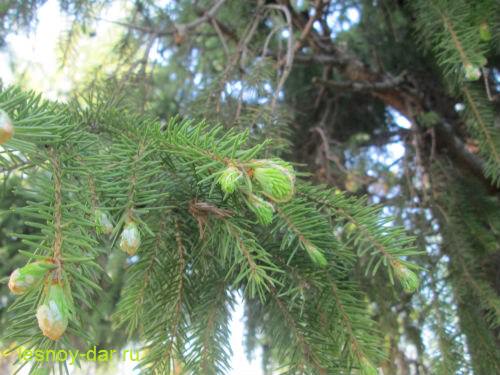
Young needles differ from old ones not only in color. They are soft and not scratchy at all. If the “brush” is torn off and chewed, a sour taste is felt. And no resinous aftertaste or aroma.
Young shoots grow rapidly. In May - early June, they still differ from the old ones in the color of their needles. But with the advent of this summer, the growth of shoots stops, the needles harden and acquire their usual properties.

Almost simultaneously with the vegetative buds, the generative buds also bloom. Modified spruce shoots appear from them - its female and male cones. Spruce "blooms". This happens almost simultaneously with the flowering of bird cherry.
Of course, biologists correct - conifers do not bloom, they do not have a flower. But still, the similarity is great, especially when you consider that the cones at this time look very spectacular.
There is a separate article in more detail about the "flowering" of spruce.
It is usually quite difficult to examine young spruce cones, since they are located in the upper part of the crown. Unless you're lucky ... Small yellow or reddish male cones (or male spikelets) appeared on the tops of last year's shoots. Huge amounts of pollen ripen in sacs under the scales.

Pollen grains of common spruce, like pine, have air sacs, due to which they specific gravity small Pollen is carried away by the wind, covers the leaves of trees, grass. If it rains, yellow pollen is clearly visible in the puddles.
If you are still not subscribed to the news of the Forest Storeroom blog, I recommend that you do it right now. There are many more interesting and useful things ahead!
 By clicking on the picture, you consent to the newsletter, the processing of personal data and agree to c
By clicking on the picture, you consent to the newsletter, the processing of personal data and agree to c